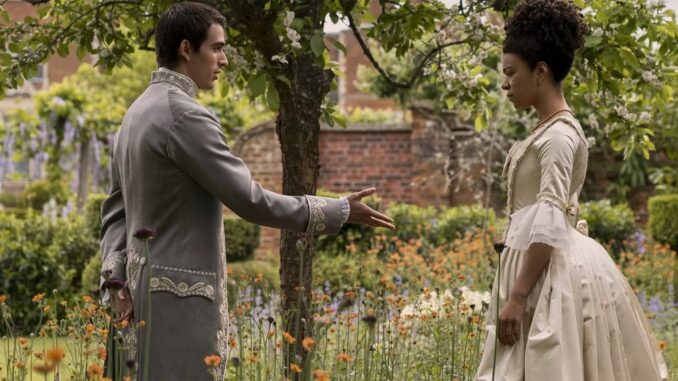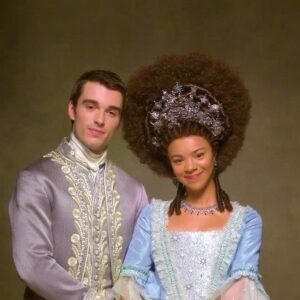
Queen Charlotte Editors On Establishing Bridgerton’s World & Enhancing Chemistry
Matt Pevic & Denise Chan, who edited the first 2 episodes of Queen Charlotte, discuss working with Shonda Rhimes and balancing romance with politics.
Queen Charlotte: A Bridgerton Story has been one of Netflix’s crown jewels in 2023, quickly rising to the top spot globally and building on the success of its parent series, Bridgerton. The prequel follows a young Charlotte (played by India Amarteifio) and her marriage to King George (Corey Mylchreest), which eventually grows into a beautiful love as they face his mental health crises together. To make way for their match, the Princess Dowager (Michelle Fairley) orchestrates a Great Experiment to elevate wealthy citizens of color to the status of nobility, and the newly-christened Lady Danbury (Arsema Thomas) must fight to maintain her position in the face of personal upheaval.
The world of Bridgerton was well-established in seasons 1 and 2, but Queen Charlotte had the duty of explaining its origins. To achieve a sense of continuity, the prequel series incorporated present-day scenes with Charlotte and other familiar actors, while the creative team employed the same musical aesthetic as Bridgerton and a similarly colorful costume palette. But making the world believe in George and Charlotte’s romance while also effectively tying it to the alternate universe of the original series was a Herculean task that required all hands on deck.
Screen Rant spoke to editors Matt Pevic and Denise Chan, who edited the first and second episodes of Queen Charlotte respectively, about their experiences in Shondaland. The two make up an editing team, with Chan serving as assistant editor on episode 1 before she and Pevic tackled episode 2 as co-editors. The duo discussed their collaboration with Shonda Rhimes and their admiration for India and Corey’s chemistry.
Matt Pevic & Denise Chan Talk Queen Charlotte: A Bridgerton Story

Matt Pevic: The job of editors is to take in all of the footage that is shot throughout the project and make sense of it. We take the wide shots, medium shots, close-ups, and specialty shots, then put them all together in a style that helps enhance the writing, acting, directing, and cinematography. Our job as editors is trying to elevate everything; heighten the emotions of the story or enhance performances as best we can.
I’ve been with Shondaland for over a decade, so I was back when they were on ABC. That was a different situation than it is now, where we’re at streaming with Netflix. Almost on every project, there tends to be three sets of editing teams. Denise and I are a team, so we had the first two episodes. On longer series, you’re going to end up editing a lot more episodes, but that’s generally how it goes. Every once in a while an editor might get to do an entire series, but in general, they separate it out by team.
Denise, when going from assistant editor in episode 1 to co-editor in episode 2, which aspects established by Matt did you want to build on or did you need to shift tonsally?
Denise Chan: First of all, I love being able to collaborate with Matt. He’s so generous with his mentorship, letting me come in and play with the episode and work with him on it. It’s fantastic. I see him as my first producer; he’s my first line of defense. I’m cutting something and watching his reaction, so he is my first customer. I always want to make sure that the audience is reacting well.
We could disagree on certain things, like maybe who the story belongs to or what perspective we focus on, but we talk about it. It’s like, “Okay, what direction are we going to take this?” Then we figure out what we can try, and I’m always very open to trying. That process of going about it is really wonderful, and it just makes the story much stronger.
The show is mainly about Charlotte and George’s romance, but it is also responsible for establishing the political reality we see in Bridgerton. How does editing come into play when balancing both those aspects of Queen Charlotte?
Matt Pevic: I would say that, in every relationship that I am looking at from an editorial perspective, we’re looking at a power dynamic. That’s the nature of a scene, especially a two-person scene, right? You’re looking at who has the push and who has the pull, and who we’re going to favor to enhance that power dynamic. Then we come to a resolution at the end of the scene, and we move on.
In balancing the political nature of this story with that love story, we find that they are really intertwined beautifully. The political is told in the love story, and the love story is told in the political aspects. It’s about joining together; about people uniting — and I think that is a genuine theme that Shonda looked for as she wrote the story. How can we unite people of different cultures, aspects, and creeds? It’s Bridgerton’s first gay couple uniting together; it’s black and white.
